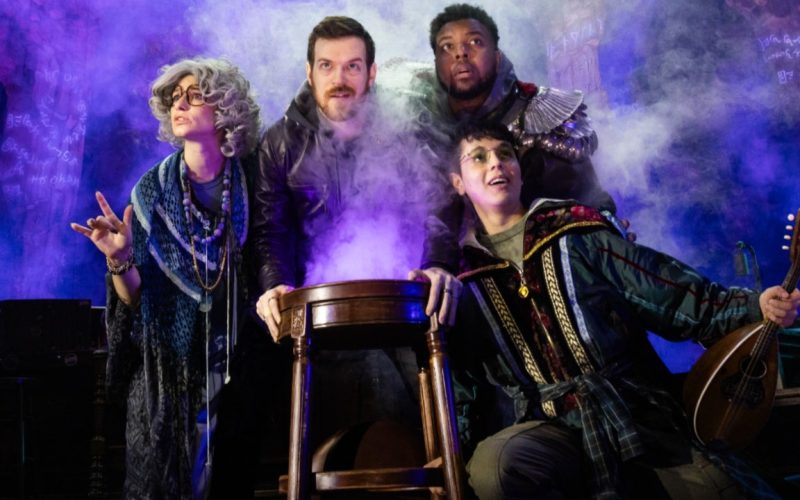Dungeons & Dragons: The Twenty-Sided Tavern Overview
Dungeons & Dragons: The Twenty-Sided Tavern is now showcasing at Stage 42 in the bustling city of New York.
Are you interested in just observing the fun? The innovative semi-interactive show Dungeons & Dragons: The Twenty-Sided Tavern, currently being performed off-Broadway at Stage 42 in New York, challenges this idea. Each night, a new and mostly improvised session of the timeless role-playing game unfolds, complete with engaging elements that keep the audience participating – at least to a certain extent. By the second act, ardent D&D enthusiasts may start feeling disengaged. However, for more casual fans, Twenty-Sided Tavern offers a lively, heartwarming experience.
This reviewer considers themselves a casual D&D fan, despite not being an active player – in fact, they were politely asked to step away from a regular group for constantly stalling the action with their indecisive character. This inclination towards inactivity is accepted at Twenty-Sided Tavern, where the audience votes on pivotal decisions via their phones and witnesses them unfold on stage. While attendees can engage more deeply and even join the cast, it is entirely on a voluntary basis. The web-based voting software, developed by Gamiotics, is seamlessly integrated and thankfully free of glitches.
Insight into Dungeons & Dragons: The Twenty-Sided Tavern
Our charming host for the evening is DAGL (or David Andrew Laws), also the co-creator of the show and the Dungeon Master of the game. DAGL offers a brief introduction to D&D to kick off the proceedings but mostly keeps the momentum going, prioritizing speed over detailed explanations of the game’s intricate rules. If newcomers feel lost at terms like “difficulty class” or “dexterity modifier,” the action moves too swiftly for them to get bogged down by it.
DAGL introduces us to the three adventurers of the evening: a Warrior (Tyler Nowell Felix), a Mage (Madelyn Murphy), and a Trickster (Diego F. Salinas). On the Saturday night of the opening weekend, the trio assumed audience-selected identities of Chester the Good Time Bro-barian, Dustin the Undead Cowboy, and Tamberlaine the Tantalizing Bard, respectively. Each adventurer has a third of the audience voting on their crucial choices. The controlling viewers also receive various challenges, such as Mario Party-style quick-tap games, to assist their character at critical junctures.
Performance and Set Design at The Twenty-Sided Tavern
The energy tends to dip during the actual gameplay, not due to confusion – though, at times, it might be confusing – but because watching people roll dice can only be so riveting. Without sufficient reasons to invest in the characters or the outcome of their journey, these segments of The Twenty-Sided Tavern suffer further. The attempts at humor did not aid the situation either: During my visit, Felix, Murphy, and Salinas relied on a tired, repetitive running joke about restoring “The Bro Code” by vanquishing a vaguely defined antagonist. Not exactly conducive to compelling emotional arcs.
Those moments of spontaneity and unpredictability keep Twenty-Sided Tavern engaging. DAGL, a delightful host and captivating storyteller, contributes to this energy. Though he indulges in cheesy humor (he hails “Undead Weird Cowboy” as “the coolest set of words I’ve ever gotten to say”), DAGL holds the show together, with valuable support from the Tavern Keeper (the wry Sarah Davis Reynolds, also a co-creator and story designer).
Experience and Audience Interaction
Mike Wood’s dazzling lighting extends to the back of the venue, involving the entire crowd in the adventure. The essential projection design, by Derek Christiansen and Ruby O’Brien, conjures up a range of vibrant settings through intricate drawings. A scaled-down version of the production could easily tour the country, and it wouldn’t be surprising if it did.
The Twenty-Sided Tavern thrives on imaginative design, strong performances, and engaging crowd interaction for the majority of its runtime. The audience’s enthusiasm is infectious, and there is a welcoming, supportive atmosphere in the theater. My fellow attendees erupted into cheers when Felix rolled a “Natural 20” – in response, he paraded through the entire venue. Together, we invoked the one-time opportunity to redo a disastrous dice roll that jeopardized the final showdown. “RE-ROLL!!” hundreds of voices clamored at the stage, much to the delight of the performers.
However, the show overlooks another pivotal element of both a great D&D game and exceptional theater: a compelling narrative. Towards the end of the performance, DAGL abruptly transitions into an emotional, earnest monologue, declaring that the troupe’s triumph eradicates all malice and darkness from the world. This moment falls flat because, prior to this instance, the show never treated its storyline with sincerity. Twenty-Sided Tavern thrives on playful humor and self-deprecation, making it an entertaining experience. But ultimately, I left feeling somewhat unfulfilled.
